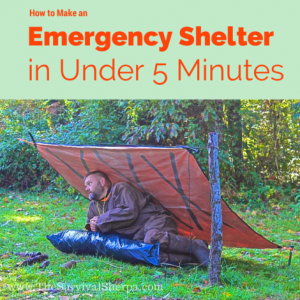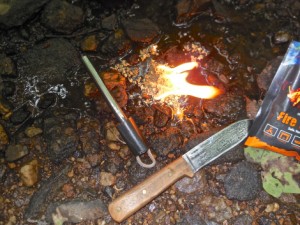Your footing gives way and you body is immersed in 45º water. The clock is ticking. Within 15 minutes, you’ll begin to lose dexterity in your fingers. You need shelter and fire.
What’s in your kit to help you erect a quick shelter and fire?
I uploaded my first ever YouTube video covering this topic. Check out my channel [2] if you get a chance. I’d greatly appreciate any honest feedback from you on the video. The following is an outline of what I covered.
Here’s the stuff you’ll need for shelter and fire:
Emergency Shelter
- Emergency space blanket
- 4 ABS tent pegs
- 25 feet of cordage
Hopefully, you keep an emergency space blanket in your outdoor kit. If not, get one! They add a little weight but have many redundant uses.
Before even heading out to the woods, prep your space blanket. Pre-install loops while you’re warm and dry. Tie a loop of cordage (#36 tarred bank line or paracord) in the four corners of your space blanket. I prefer the smaller diameter on the bank line. I used a necklace knot for the loops. Make the loops about 3 or 4 inches long… enough to slip a tent peg through.
Another time-saving tip: Practice this set up in your backyard. Keep a bowline knot tied on one end of your ridge line. Attach your pursik loop to the ridge line and leave it there. This will trim valuable minutes off your shelter set up in an actual emergency.
Fire
- Ignition source
- Tinder
- Smalls (pencil lead and pencil size twigs)
- Cutting tool
Practicing primitive fire craft in a controlled setting is smart, but you need fire now! Building a bow drill set off the landscape won’t cut it when you’re losing fine motor skills and finger dexterity at a rapid rate.
Wet and cold, you need fire fast! Always keep layers of sure-fire sources in a dry bag in your kit. A Bic lighter in your pocket, even wet, can be dried by blowing and shaking water out of the valve and striker. Ferro rods work in all weather conditions.
In my video, I collected a drum liner of smalls on my way to the site. This process takes the most time but is essential to creating a sustainable fire. In the eastern woodland, look for dead hanging limbs that snap when harvested.
Your fire kit should also be prepped with a bullet proof tinder material. Commercially made products like Mini Infernos or InstaFire [3] burn for several minutes in wet conditions… even on water.
Processed jute twine is a flash tinder that burns quickly and may not ignite marginal or damp tinder and smalls. Click here for a DiY option on jute fire starters [5] that burn for several minutes. Whatever you decide, commercial or homemade, it’s your job to test these items before you actually need them.
In Georgia, we have an abundance of fatwood. A couple of sticks always ride in my fire kits. For demonstration purposes on the video, I used fatwood. Create a pile of fatwood shavings with the spine of your knife if you have no other sure-fire starter. The increased surface of the shavings allows ignition with a spark from your ferro rod. Add a fatwood feather stick to the lit shavings and let the fire eat the smalls. This gives you time to add larger fuel as needed.
You can view my 32 ounce water boil on the video.
Knots
- Bowline
- Necklace/Blood knot
- Trucker’s hitch
- Prusik loop
These four knots are most useful in woodcraft and survival. Grab a length of cordage and practice tying the bowline, the king of bush craft knots, while you watch TV or stand in line at the store. Simply ignore the stares. Practice until you are able to tie one with your eyes closed. I’ll do a short video on tying these 4 knots soon.
Here’s my first attempt at videos. Thanks for watching.
Keep Doing the Stuff of Self-Reliance,
Todd

